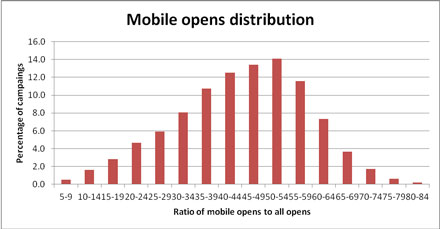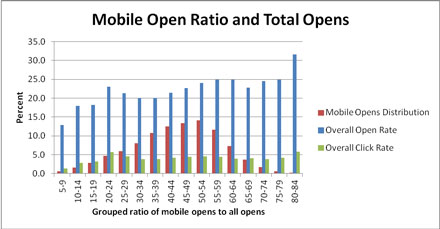 Emails opened on a mobile devices are now averaging 43% of opened emails (source Litmus) with some brands and campaigns much higher than 43%.
Emails opened on a mobile devices are now averaging 43% of opened emails (source Litmus) with some brands and campaigns much higher than 43%.
There’s advice aplenty for creating a better user experience on mobile devices and use of responsive design in email templates. But just how important is it? Should this be your number one priority? The data suggests not.
The logic behind the need for mobile design is self-apparent. If users get a poor experience of your email on a mobile device then they are going to delete and ignore you.
If you’ve ever tried to use a website on a mobile device that’s intended for desktop use, then you’ll know just how frustrating it is and how quickly you give up.
Emails are somewhat simpler than websites; just scan read and maybe click on one or two things. Not the same sort of reading, form filling, navigating, multimedia interaction of a website.
Is the typical email today too bad for mobile use? Just how good does an email need to be for mobile use and just how far short are emails today? This was worrying me and I got chatting with Steve Henderson from Communicator Corp. We started developing some theories and Steve went to work looking for evidence and data to verify or reject these ideas.
The first question to answer was that whilst 43% of opens are mobile, as reported last December by Litmus, what is the spread like? Are all brands seeing something very close to this? Are some brands so unaffected they don’t need to consider mobile?
Mining the data from 377 million emails, 339 brands and 12,000+ campaigns we charted the number of campaigns against the ratio of opens on a mobile device to all opens for each campaign.
The chart below shows the result of this first step in analysis.

For example, this chart shows that 14% of all campaigns analysed showed the ratio of opens on a mobile device to all opens was in the range 50% to 54%.
There’s a good spread with most campaigns in the range of 25% to 65% of opens happening on a mobile device. There are still campaigns at both ends, some with almost no mobile activity and some with almost only mobile activity. It’s possible your campaigns sit at one of the ends and not the middle. If you’re at the bottom end then mobile optimisation is crucial issue for you.
To answer the question of how important is mobile design we need look at open and click rates across this chart. If emails not optimised for mobiles are providing a significantly poorer user experience then I would expect to see the average opens and clicks lower for those campaigns in which a high number of opens on mobile devices occur.
The next chart is the same as the previous but with average open and click rates for each of the vertical bars added.

Surprise! The open and click rates don’t vary much compared across the chart and certainly no downward trend that would show mobile email is an issue for consumers. The open rate actually shows an upward trend. This is most likely due to the iPhone loading images by default and therefore triggering open tracking by default. The click rate is a more honest measure and is almost flat.
There’s nothing here to say that open and click rates are in danger of dropping because of consumers moving to mobile devices. Actually, the average email works to an acceptable degree without modification. Smartphones do a good job of making email usable. Is responsive design just another bandwagon you don’t need?
The self-apparent conclusion that responsive design is a must goes unproven. I’ve discussed email mobile design with some of the most experienced responsive design gurus in the industry. They’re telling me in some cases they have seen good uplifts as a result of responsive design.
How can responsive design deliver an improved response with the evidence above showing it’s totally unnecessary? One reason could be because the method of measuring success of a responsive design has not been robust – with multiple factors changing, different offers, external factors, timing and much more.
There’s another reason too. Mobile first thinking and responsive design applies a much stronger focus to key campaign objectives and drops all the clutter in the email. Screen space is a premium so only the important content, links and calls-to-action are included. Even more the calls to action and headings are made even bolder.
A responsive design is just a new design and any uplift seen is not because of design for mobile but simply designing a better performing template.
Right now my conclusion is simplify your template, make it focused and get rid of the clutter. It will just work better, regardless of desktop or mobile.
Finally, a note about the bars at either end of the chart: the very low end is showing reduced opens and clicks and the very high end increased. There are two reasons for the outliers performing like this.
• In the sample data there are not many campaigns at either end, meaning individual brands are skewing the results.
• At the low end a B2B brand with informational emails that don’t require open or a click to be useful has pulled the average down and at the high end a brand is sending some mobile specific emails to only customers who open on mobiles, pulling the average up.
I was recently speaking at the big Email Evolution conference in Miami and discussed in one session the pros and cons of responsive design for email with brands who had created mobile websites and looked at email performance on mobile. They agreed with the general view that responsive design is not always necessary and in the session other people shared their stories of sometimes it helped and sometimes it didn’t.
Footnote:
The following assumptions about the data used this analysis have been verified as reasonable:
• The customer base of each brand varies in the number of mobile users
• No one brand sent sufficiently large number of campaigns compared to the other brands to skew the results
• The brands included have typically the same amount of mobile optimisation, it is not the case that brands with more mobile users are typically more optimised for mobile
• Different campaigns are not generally sent to a mobile/non-mobile customer or targeted on mobile activity
• Mobile opens in the analysis includes smartphones and tablet devices
